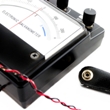Electrodermal testing
Electrodermal testing
Natural Standard Monograph, Copyright © 2013 (www.naturalstandard.com). Commercial distribution prohibited. This monograph is intended for informational purposes only, and should not be interpreted as specific medical advice. You should consult with a qualified healthcare provider before making decisions about therapies and/or health conditions.
Related Terms
Acupuncture, EAV, electrical resistance, electrodermal testing (EDT), electroacupuncture, homeopathy, Vega test, Wheatstone bridge.
Background
Electrodermal testing (EDT) is an acupuncture-based approach and was developed to refine homeopathic prescriptions.
EDT is currently being used as a diagnostic technique to advise patients about allergies. However, the evidence for its use in allergy testing is limited and often misrepresented.
Theory/Evidence
The nervous system conducts electricity, but becomes more resistant when presented with a substance that the body recognizes as a potential threat. This is the basis for identifying substances that may cause an inappropriate reaction when they come into contact with the immune system. Foods, additives and medications that do not affect the normal reading are passed as non-problematic. Any substances that impede the ability of the nervous system to conduct the current normally, giving a low reading, are identified as possible allergens.
One study at Southampton University concluded that this kind of testing could not diagnose allergies to common allergens such as the house dust mite, and that it was inappropriate for diagnosing any immediate hypersensitivity. More studies are needed to make any firm conclusions regarding the safety and efficacy of electrodermal testing.
Technique
Electrodermal testing utilizes an apparatus called a Wheatstone bridge, which measures electrical resistance by passing a small electric current between two points of the body.
The apparatus must be specifically calibrated for each individual.
During testing, the patient holds one electrode in one hand while the doctor carries out the necessary calibration using a second electrode to complete the circuit, usually on the patient's foot.
The normal level of current flowing through the body is then measured on a galvanometer.
Each substance to be tested is placed into the circuit in turn and a reading of the resulting electrical flow is taken; each reading takes about 15 seconds to assess.
Author Information
This information has been edited and peer-reviewed by contributors to the Natural Standard Research Collaboration (www.naturalstandard.com).
Bibliography
Natural Standard developed the above evidence-based information based on a thorough systematic review of the available scientific articles. For comprehensive information about alternative and complementary therapies on the professional level, go to www.naturalstandard.com. Selected references are listed below.
Lewith GT. Can we evaluate electrodermal testing? Complement Ther Med. 2003 Jun;11(2):115-7. View Abstract
NOMA (Complex Homeopathy). Basic Vega Testing Protocol Course. Southampton, pp1-82, 1995.
Krop J, FaaemGT, Lewith GT, et al. A double-blind, randomised control investigation of Electrodermal Testing in the diagnosis of allergies. J Alternative and Complementary Medicine. Vol 3, No 3, 1997, pp 241-248. View Abstract
Copyright © 2013 Natural Standard (www.naturalstandard.com)
The information in this monograph is intended for informational purposes only, and is meant to help users better understand health concerns. Information is based on review of scientific research data, historical practice patterns, and clinical experience. This information should not be interpreted as specific medical advice. Users should consult with a qualified healthcare provider for specific questions regarding therapies, diagnosis and/or health conditions, prior to making therapeutic decisions.
Updated:
March 22, 2017
